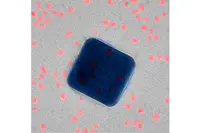 Researchers from North Carolina's Duke University have developed an ultrafast light-emitting device that can flip on and off 90billion times a second and could form the basis of optical computing.
Researchers from North Carolina's Duke University have developed an ultrafast light-emitting device that can flip on and off 90billion times a second and could form the basis of optical computing.
In a study, a team from the Pratt School of Engineering pushed semiconductor quantum dots to emit light at more than 90GHz. This so-called plasmonic device could one day be used in optical computing chips.
"This is something that the scientific community has wanted to do for a long time," said Maiken Mikkelsen, assistant professor of electrical and computer engineering and physics at Duke. "We can now start to think about making fast-switching devices based on this research."
When the researchers shone a laser on the surface of a silver cube 75nm wide, the free electrons on its surface began to oscillate together in a wave. These oscillations create their own light, which reacts with the free electrons. Energy trapped on the surface of the nanocube in this fashion is called a plasmon.
The plasmon creates an intense electromagnetic field between the silver nanocube and a thin sheet of gold placed 20 atoms away. This field interacts with quantum dots that are sandwiched between the nanocube and the gold. The quantum dots, in turn, produce a directional, efficient emission of photons that can be turned on and off at more than 90GHz.
"There is great interest in replacing lasers with LEDs for short-distance optical communication, but these ideas have always been limited by the slow emission rate of fluorescent materials, lack of efficiency and inability to direct the photons," said Gleb Akselrod, a postdoctoral researcher in Mikkelsen's laboratory. "Now we have made an important step towards solving these problems."
The group is now working to use the plasmonic structure to create a single photon source - a necessity for secure quantum communications - by sandwiching a single quantum dot in the gap between the silver nanocube and gold foil. They are also trying to precisely place and orient the quantum dots to create the fastest fluorescence rates possible.
Pic: A nanoscale view of the superfast fluorescent system using a transmission electron microscope. The silver cube is 75nm wide. The quantum dots (red) are sandwiched between the silver cube and a thin gold foil.
Author
Tom Austin-Morgan
Source: www.newelectronics.co.uk

